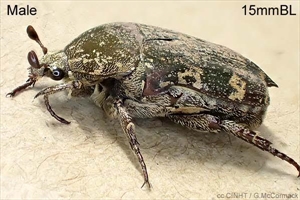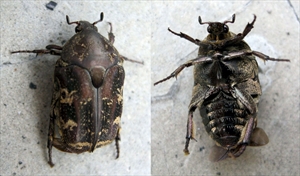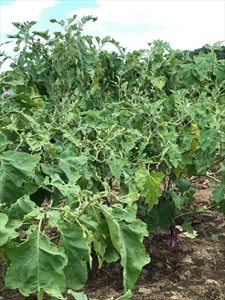Mango flower beetle, Asian mango flower beetle, mottled flower scarab.
Pacific Pests, Pathogens and Weeds - Online edition
Pacific Pests, Pathogens & Weeds
Mango flower beetle (367)
Protaetia fusca
Asia, Africa (Mauritius), North America (Florida, Hawaii), Caribbean, Oceania. It is recorded from Australia, Cook Islands, Fiji, French Polynesia, Guam, New Caledonia, Northern Mariana Islands, Papua New Guinea, Samoa, and Tonga.
Plants in several families are hosts. This includes avocado, peach, bean tree (Cassia brewsteri) (Queensland, Australia); coconut flowers (Malaysia); maize, mango, pigeon pea, yellow and white ginger, candle flower (Cassia alata), African rattlebox (Crotalaria saltiana), poinciana trees and roses (Hawaii). Citrus, figs, guava, longan, lychee and orange jasmine, and more are also hosts. It has also been reported to attack nests of Trigona, the stingless bee, in Queensland.
The adult beetles damage flowers of many ornamentals, crops and trees in their attempts to feed on pollen and nectar (Photos 1-3). They also feed on overripe fruit and sap (Photo 4). Eggs are laid in vegetable refuse of different kinds (e.g., sugarcane or coffee); the larvae hatch and feed on organic matter reaching maturity in about 50 days. They are C-shaped, and 'crawl' on their backs with their legs up, typical of the genus. The adult lifespan is 6-7 months. Adults are 12-17 mm long, broad, oval, flat, dark brown with pale markings.
Spread over short distances occurs on the wing; long-distance spread is likely associated with the trade in ornamental plants and in transport of cargo by sea and/or air. It is thought possible that the mango flower beetle might spread in consignments of fruit.
The adult beetles damage flowers of many kinds of ornamentals, food crops and trees in their attempts to feed on pollen and nectar. In Fiji, there is moderate damage to eggplant; however, it is not known if this affects yield, although farmers complain that numbers of fruits are reduced (Photos 5-7)
Look for the dark brown colour of the adults, and their ill-defined light (greenish yellow to white) markings on the wing cases. Larvae are said to be 'squishy', and crawl on their backs. There are other species in Guam and Hawaii, but they are larger, over 19 mm long.
NATURAL ENEMIES
A parasitoid wasp, Scolia vollenhoveni, is recorded in Malaysia. Campsomeris annulata from Guam, and Tiphia paralella from Mauritius were introduced into Hawaii in attempts at biological control.
CULTURAL AND CHEMICAL CONTROL
As it is uncertain that the mango flower beetle causes damage of economic important on a majority of its hosts, control measures are unnecessary. On trees such as avocado, mango, peach, longan, and others, the application of control measure would be very difficult even if economic damage was shown to occur.
In situations where the beetle is numerous, handpicking might have potential as adults are slow moving.
Interestingly, work on fruit fly trapping in Hawaii, using methyl eugenol, caught large numbers of a related species, Protaetia orinetalis, and also Protaetia fusca, but more infrequently. Further tests with this chemical should be done, especially where Protaetia fusca is in high numbers and damaging.
If pesticides were warranted, plant-derived-products, such as derris, neem or pyrethrum are likely to be effective against adults, so too are synthetic pyrethroids.
____________________
When using a pesticide, always wear protective clothing and follow the instructions on the product label, such as dosage, timing of application, and pre-harvest interval. Recommendations will vary with the crop and system of cultivation. Expert advice on the most appropriate pesticide to use should always be sought from local agricultural authorities.
AUTHOR Grahame Jackson & Mani Mua
Information from Woodruff RE (2016) The Asian mango flower beetle, Protaetia fusca (Herbst), and Euphoria sepulcralis (Fabricius) in Florida and the West Indies (Coleoptera: Scarabaeidae: Cetoniinae). Insecta Mundi 20(3-4): 227-231. (https://digitalcommons.unl.edu/cgi/viewcontent.cgi?article=1113&context=insectamundi); and Hawaiian scarab id Protaetia fusca. (http://idtools.org/id/beetles/scarab/factsheet.php?name=15219); and from Leblanc L et al. (2013) Protaetia orientalis (Coleoptera: Scarabaeidae) attracted to methyl eugenol fruit fly lure. Proceedings of the Hawaiian Entomological Society 45:45-48. Photo 1 McCormack G (2007) Cook Islands Biodversity Database, Version 2007(2). Cook Islands Natural Heritage Trust, Rarotonga. (http://cookislands.bishopmuseum.org). Photos 2&4 Bramadi Arya. (https://commons.wikimedia.org/wiki/File:Protaetia_fusca_(Herbst).jpg).
Produced with support from the Australian Centre for International Agricultural Research under project HORT/2016/185: Responding to emerging pest and disease threats to horticulture in the Pacific islands, implemented by the University of Queensland and the Secretariat of the Pacific Community.










